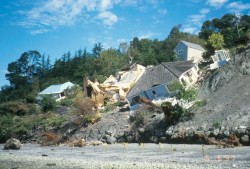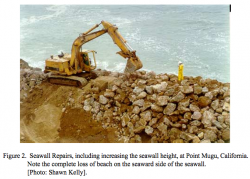“Seawalls damage virtually every beach they are built on. If they are built on eroding beaches—-and they are rarely built anywhere else,—-they eventually destroy the beach. ” –Cornelia Dean, (Science Editor of the New York Times) Against the Tide, The Battle of America’s Beaches 53 (1999)
A serious problems which has developed on the coastline of Metchosin, is the building of seawalls under the pretext of protecting private property from erosion. Owners of properties along a coast are often not aware of the mechanics of the interaction with ocean energy of the shoreline. After an intense storm, evidence of erosion along a shore-front often leads land owners, desperate to save their property to go to often very expensive extremes in order to try to protect their property.
A survey of literature from various parts of the world indicates this is not only a local problem, but is indeed very wide spread. The series of photographs documented on this website from Puget Sou nd, show the problem not far from our shores. We should consider ourselves lucky so far in Metchosin as we have yet to experience the disasters that have happened in Puget Sound. This link to an Image Gallery shows how bad it could get:
nd, show the problem not far from our shores. We should consider ourselves lucky so far in Metchosin as we have yet to experience the disasters that have happened in Puget Sound. This link to an Image Gallery shows how bad it could get:
Impact of Coastal Erosion in Australia 7 Mar, 2013
Senior Coastal Scientist at Coastalwatch Professor Andrew Short has compiled a comprehensive piece focusing on coastal erosion in Australia.
For the 50% of the Australian coast that is composed of sand and in some places mud, the shoreline is prone to change, building seaward and in some places eroding landward. In most locations this is a natural process with usually no impact on human settlement. Coastal protection of the shoreline is rarely required in Australia, however in a few locations the dynamic shoreline has become a problem, in some cases a major and expensive problem, and in almost all of these cases the problem is related to human interference or encroachment on the shoreline. Coastal protection works, such as breakwaters, groynes, or seawalls, are usually built to guard against erosion. In doing so they harden the coast and reduce its ability to adjust naturally. As a consequence, these defences can exacerbate further erosional problems, with seawalls reflecting and concentrating wave energy and erosion, and groynes starving downdrift the coast of sediment thereby leading to further erosion. There are areas where human have encroached into the dynamic beach environment only to suffer the consequences, and others where they have interfered with coastal processes leading to accelerated coastal erosion.
Executive Summary
See the full PDF version: Seawall
 When coastal buildings or roads are threatened, the typical response is to harden the coast with a seawall. Seawalls run parallel to the beach and can be built of concrete, wood, steel, or boulders. Seawalls are also called bulkheads or revetments; the distinction is mainly a matter of purpose. They are designed to halt shoreline erosion caused primarily by wave action. If seawalls are maintained, they may temporarily hold back the ocean from encroaching on shoreline development. In spite of their ability to hold back the ocean, when waves hit a seawall, the waves are reflected back out to sea, taking beach sand with them and eventually causing the beach to disappear. Moreover, seawalls can cause increased erosion at the ends of the seawall on an adjacent beach that is not walled. Alternatives to seawalls exist, such as beach nourishment and managed retreat. Making coastal land use decisions that ensure a seawall will not be needed in the
When coastal buildings or roads are threatened, the typical response is to harden the coast with a seawall. Seawalls run parallel to the beach and can be built of concrete, wood, steel, or boulders. Seawalls are also called bulkheads or revetments; the distinction is mainly a matter of purpose. They are designed to halt shoreline erosion caused primarily by wave action. If seawalls are maintained, they may temporarily hold back the ocean from encroaching on shoreline development. In spite of their ability to hold back the ocean, when waves hit a seawall, the waves are reflected back out to sea, taking beach sand with them and eventually causing the beach to disappear. Moreover, seawalls can cause increased erosion at the ends of the seawall on an adjacent beach that is not walled. Alternatives to seawalls exist, such as beach nourishment and managed retreat. Making coastal land use decisions that ensure a seawall will not be needed in the“The Streisand effect”
In Canto 21 of the Inferno, Dante watches lawyers who made a habit of bringing frivolous or oppressive suits being perpetually submerged in a lake of boiling tar by demons with boathooks. They get off quite lightly, in other words. But perhaps hell of a different kind awaits on earth. It’s called the Streisand Effect. In 2003 Barbra Streisand’s lawyers launched an action to have an aerial photograph of her home in Malibu removed from a collection of 12,000 such shots, whose purpose was to document coastal erosion(11). They demanded $50m in damages. Before they became involved, the photo was downloaded four times. In the month after they launched their stupid suit, it was downloaded 420,000 times(12). “The Streisand Effect,” in other words, is blowback: disastrous unintended consequences of an attempt at censorship.”
